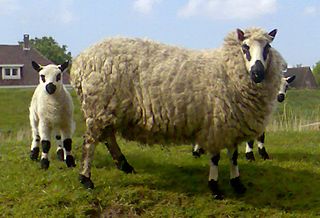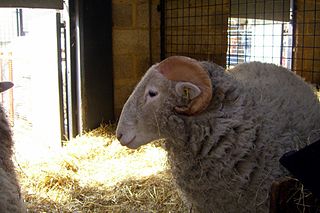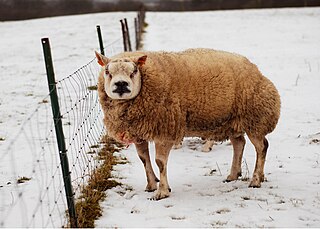Related Research Articles

The Targhee is an American breed of domestic sheep. It was developed in the early twentieth century at the U.S. Sheep Experiment Station of the Agricultural Research Service of the United States Department of Agriculture at Dubois, Idaho, and is named after the Targhee National Forest which surrounds it. It is a dual-purpose breed, with heavy, medium-quality wool and good meat production characteristics. It is hardy and well-suited to the ranges of the West where it was developed. It is kept mainly in Montana, Wyoming and South Dakota, and is reared primarily for wool.

The Bluefaced Leicester (BFL) is a longwool breed of sheep which evolved from a breeding scheme of Robert Bakewell, in Dishley, Leicestershire in the eighteenth century. First known as the Dishley Leicester, and then the Hexham Leicester, because of the prevalence of the breed in Northumberland, the name Bluefaced Leicester became known at the beginning of the 20th century. In the 1970s, the Bluefaced Leicester was exported to Canada. Exported frozen semen from the United Kingdom is now used to expand the genetic diversity in Canada and the United States. It is raised primarily for meat.
The Debouillet is a breed of domestic sheep originating from Tatum, New Mexico. It was developed in the 1920s through crossing Rambouillet and Delaine Merino sheep and the breed's name is a portmanteau of these two ancestors. This breed is primarily raised for its wool.

The Kerry Hill is a breed of domestic sheep originating in the county of Powys in Wales. It derives its name from the village of Kerry (Ceri), near Newtown. Kerry Hill sheep have a distinctive and unique coloration, with a white face bearing black markings around the mouth, ears, and eyes. Both rams and ewes are polled. Their wool is white, and their legs are white with black markings. First mentions of the breed date back to the early 19th century, and today it is distributed throughout the United Kingdom, Ireland, the Netherlands, Germany and Denmark. Though still not very numerous, the breed was removed from the records of the Rare Breeds Survival Trust watchlist in 2006. This breed is primarily raised for meat.

The Whitefaced Woodland is a sheep breed from the Woodlands of Hope an area in the South Pennines in England. It is a combination of two breeds, the Woodland and the Penistone sheep after the Yorkshire town where sheep sales have been held since 1699. It is thought to be closely related to the Swaledale and the Lonk. Substantial commercial flocks of the Whitefaced Woodland are kept in its region of origin, but it is listed as a vulnerable breed by the Rare Breeds Survival Trust, since there are fewer than 900 registered breeding females in Great Britain.

The Basco-Béarnaise or Vasca Carranzana is a breed of domestic sheep originating in the Basque country. It was developed from Basque and Béarnaise sheep during the 1960s to be a single-purpose milk breed.

The Beltex is a breed of heavily muscled domestic sheep. A portmanteau of Belgian and Texel, the name reflects the breed's origin as an offshoot of Texel sheep from The Netherlands. In the late 1980s, Belgian Texels were exported to the United Kingdom, and it was there that it was primarily refined into its modern form. It is primarily used in Europe as a terminal sire, meaning Beltex rams are prized for mating with ewes to produce lambs for meat.

The Racka or Hortobágy Racka Sheep is a breed of sheep known for its unusual spiral-shaped horns. These unique appendages are unlike any other domestic sheep horns, and may grow up to 2.0 ft (0.61 m) long. The smallest standard length is 20 in (51 cm) for rams and 12–15 in (30–38 cm) for ewes.
The Damani is a thin-tail, meat and wool breed of sheep which is found in the Dera Ismail Khan district and part of Bannu district in Khyber Pakhtunkhwa province of Pakistan.
Alai is a breed of domesticated sheep found in Kyrgyzstan. This breed is a dual purpose breed raised for its meat and wool.
Altay is a breed of domesticated sheep originating in the dry, cold mountain basins of China. This breed belongs to the fat-rumped carpet wool type of sheep and the Kazakh group. Although the Altay grows wool, it is raised primarily for the meat.
Arabi is a domesticated breed of fat-tailed sheep from southwestern Iran, southern Iraq and northeastern Arabia and Egypt. Though it does grow wool, it is primarily raised for meat.

Algerian Arab sheep is a breed of domesticated sheep found throughout Algeria. This breed does grow a carpet-grade wool, and is raised primarily for meat.

Askanian is a breed of domesticated sheep found in Ukraine. It is a fine-wool breed bred for its wool. It was developed by crossing American Rambouillet with Merinos in the early 1900s.
The Balkhi is a domesticated breed of sheep found in Afghanistan and North-western Pakistan. This breed is of the fat-tailed mutton type. Though this breed does grow wool, it is primarily raised for meat.

The Bardoka or White Metohian sheep is a multi-purpose breed of domesticated sheep in Kosovo. It is a popular sheep in Kosovo and partially in Montenegro, Serbia and Albania. This breed appears to adaptable to all environmental conditions especially low temperatures. However, the Bardoka is sensitive to high humidity.
The Bibrik is a fat tailed, domesticated breed of meat sheep that is found in Baluchistan Province of Pakistan.

The Bizet is a domesticated breed of sheep originating from France. It grows wool but is primarily raised for meat. In 1952, the Bizet was introduced on the Kerguelen archipelago. It is utilized as food for the scientific station there.
The Cholistani is a breed of domestic sheep from Punjab, Pakistan. Though the Cholistani grows wool, it is raised primarily for meat.
The Cikta is a breed of domestic sheep from Hungary. In the 18th century, this breed was brought to Hungary by German settlers. This breed grows wool but is primarily raised for meat. The Cikta belong in the Mountain Group of sheep breeds.
References
- ↑ "Armenian Semicoarsewool". Breeds of Livestock. Oklahoma State University, Dept. of Animal Science. Retrieved 2009-05-13.
- ↑ "Armenian Semi-Coarse Wool/Armenia". Breed data sheet. Domestic Animal Diversity Information System. Retrieved 2009-05-13.